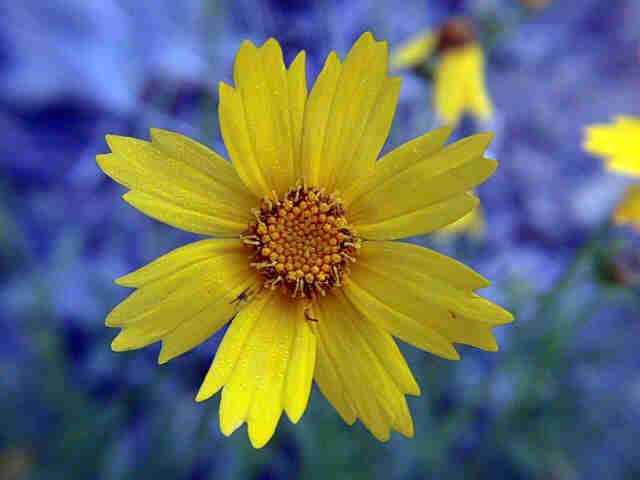The genus Coreopsis is Florida's State Wildflower. Coreopsis lanceolata, lanceleaf coreopsis, is an evergreen to semi-evergreen perennial that is one of 14 native coreopsis species found in Florida. It primarily occurs in north Florida, but has been observed as far south as Lake County. Seed from commercial sources has been planted along roadways, although native populations are also found on roadsides.
Description
Lanceleaf coreopsis has grass green foliage, with most of the leaves concentrated at the base of the plant, giving it a clumped appearance. Clumps of the Florida ecotype* (plants that occur here naturally and are adapted to Florida conditions) are about 6-8 inches tall. Foliage and clump size of the common garden variety are about two to three times greater than in the Florida ecotype.

Flowers are yellow and about 1 inch in diameter. The Florida ecotype will flower in late spring if it is directly seeded in the winter or previous autumn. However, flowering of the common garden variety is sporadic at best the first year after it is seeded, although its flowers are two to three times larger than the Florida ecotype. Mature plants of the Florida ecotype or the common garden variety that overwinter will start flowering in mid to late March, with peak bloom soon after. Moderate to sparse flowering will likely continue into August. Plants rebloom well if faded flowers are removed.
Culture
Lanceleaf coreopsis grows best in full sun in slightly moist, well-drained soil. Established plants will tolerate some short-term dry periods. It is not very tolerant of excessive water. If you wish to fertilize, use a low rate of a controlled-release fertilizer.
Tolerance to occasional freezes and frosts as low as the mid-20s has been observed for both the common garden variety and the Florida ecotype.
Pests
Lanceleaf coreopsis is relatively insect and disease free. Infrequent damage to flowers by stink bugs may occur about 1/2 inch below the flower the stem collapses where the stink bug has been feeding and the flower dies.
During late fall and winter, some plants may succumb to diseases but since the plant reseeds itself and other plants will spread, the overall planting of lanceleaf coreopsis should look good year to year.
Propagation and Establishment
Lanceleaf coreopsis can be propagated by division or by seed. Seeds need to be collected soon after they ripen because the seedheads easily shatter. If you plan to store the seed you collected, spread the seed out in a thin layer on some newspaper and let it dry for a few days. The dried seed can be stored in a paper bag in the refrigerator until it is planted.
Direct seeding into a garden or meadow can be done from October through January. Seed should be planted no deeper than 1/8 inch in a firm seedbed. During abnormally dry winters, seedbeds should be irrigated occasionally.
Propagate plants by division in the late winter or early spring.
Reference
Wunderlein, R.P. 1998. Guide to the Vascular Plants of Florida. Gainesville, FL: University Press of Florida..
*Plants of the Florida ecotype of lanceleaf coreopsis may be available at nurseries or garden centers that specialize in Florida native plants.